Quantitative Analysis of Lithium in Natural Brines from the Lithium Triangle by Laser-Induced Breakdown Spectroscopy
Abstract
1. Introduction
2. Materials and Methods
2.1. Samples
2.2. LIBS Measurements and Analysis
3. Results and Discussion
3.1. Processing and Spectral Analysis
3.2. Plama Characterization
| Species | λ0 (nm) | Aki (108 s–1) | Ei (eV) | Ek (eV) | gi | gk |
|---|---|---|---|---|---|---|
| Mg I | 277.65 | 1.32 | 2.712 | 7.175 | 3 | 5 |
| Mg I | 277.85 | 1.82 | 2.709 | 7.170 | 1 | 3 |
| Mg I | 277.97 | 1.36 | 2.712 | 7.170 | 3 | 3 |
| Mg I | 278.10 | 5.43 | 2.717 | 7.173 | 5 | 3 |
| Mg I | 278.28 | 2.14 | 2.717 | 7.170 | 5 | 3 |
| Mg I | 285.21 | 4.91 | 0.000 | 4.345 | 1 | 3 |
| Mg I | 516.73 | 1.13 | 2.709 | 5.107 | 1 | 3 |
| Mg I | 517.27 | 3.37 | 2.712 | 5.108 | 3 | 3 |
| Mg I | 518.36 | 5.61 | 2.717 | 5.108 | 5 | 3 |
| Mg II | 279.08 | 4.01 | 4.422 | 8.864 | 2 | 4 |
| Mg II | 279.55 | 2.60 | 0.000 | 4.434 | 2 | 4 |
| Mg II | 279.80 | 4.79 | 4.434 | 8.863 | 4 | 6 |
| Mg II | 280.27 | 2.57 | 0.000 | 4.422 | 2 | 2 |
| H I | 656.30 | 0.44 | 10.199 | 12.087 | 8 | 18 |
| Li I | 670.77 | 0.37 | 0.000 | 1.848 | 2 | 4 |
| Ca I | 671.77 | 0.12 | 2.709 | 4.554 | 5 | 3 |
3.3. Quantitative Li Analysis
4. Conclusions
Author Contributions
Funding
Data Availability Statement
Acknowledgments
Conflicts of Interest
References
- Flexer, V.; Baspineiro, C.F.; Galli, C.I. Lithium recovery from brines: A vital raw material for green energies with a potential environmental impact in its mining and processing. Sci. Total Environ. 2018, 639, 1188–1204. [Google Scholar] [CrossRef] [PubMed]
- Kesler, S.E.; Gruber, P.W.; Medina, P.A.; Keoleian, G.A.; Everson, M.P.; Wallington, T.J. Global lithium resources: Relative importance of pegmatites, brine and other deposits. Ore Geol. Rev. 2012, 48, 44–69. [Google Scholar] [CrossRef]
- Steinmetz, R.L.L.; Salvi, S. Brine grades in Andean salars: When basin size matters—A review of the Lithium Triangle. Earth-Sci. Rev. 2021, 217, 103615. [Google Scholar] [CrossRef]
- BP, Statistical Review of World Energy 2022, 71st ed., BP p.l.c. 2022. Available online: https://www.bp.com/statisticalreview (accessed on 3 September 2024).
- Steinmetz, R.L.; Salvi, S.; García, M.G.; Arnold, Y.J.P.; Béziat, D. Northern Puna Plateau-scale survey of Li brine-type deposits in the Andes of NW Argentina. J. Geochem. Explor. 2018, 190, 26–38. [Google Scholar] [CrossRef]
- Bustos-Gallardo, B.; Bridge, G.; Prieto, M. Harvesting Lithium: Water, brine and the industrial dynamics of production in the Salar de Atacama. Geoforum 2021, 119, 177–189. [Google Scholar] [CrossRef]
- Miziolek, A.W.; Palleschi, V.; Schechter, I. Laser-Induced Breakdown Spectroscopy (LIBS) Fundamentals and Applications; Cambridge University Press: New York, NY, USA, 2006. [Google Scholar] [CrossRef]
- Hahn, D.W.; Omenetto, N. Laser-induced breakdown spectroscopy (LIBS), part I: Review of basic diagnostics and plasma–particle interactions. Appl. Spectrosc. 2010, 64, 335A–366A. [Google Scholar] [CrossRef]
- Winefordner, J.D.; Gornushkin, I.B.; Correll, T.; Gibb, E.; Smith, B.W.; Omenetto, N. Comparing several atomic spectrometric methods to the super stars: Special emphasis on laser-induced breakdown spectrometry, LIBS, a future super star. J. Anal. At. Spectrom. 2004, 19, 1061–1083. [Google Scholar] [CrossRef]
- Hahn, D.W.; Omenetto, N. Laser-induced breakdown spectroscopy (LIBS), part II: Review of instrumental and methodological approaches. Appl. Spectrosc. 2012, 66, 347–419. [Google Scholar] [CrossRef]
- Tognoni, E.; Cristoforetti, G.; Legnaioli, S.; Palleschi, V. Calibration-Free Laser-Induced Breakdown Spectroscopy: State of the art. Spectrochim. Acta Part B 2010, 65, 1–14. [Google Scholar] [CrossRef]
- Harmon, R.S.; Russo, R.E.; Hark, R.R. Applications of laser-induced breakdown spectroscopy for geochemical and environmental analysis: A comprehensive review. Spectrochim. Acta Part B 2013, 87, 11–26. [Google Scholar] [CrossRef]
- Ytsma, C.R.; Dyar, M.D. Accuracies of lithium, boron, carbon, and sulfur quantification in geological samples with laser-induced breakdown spectroscopy. Spectrochim. Acta Part B 2019, 162, 105715. [Google Scholar] [CrossRef]
- Ferreira, M.F.S.; Capela, D.; Silva, N.A.; Gonçalves, F.; Lima, A.; Guimaraes, D.; Jorge, P.A.S. Comprehensive comparison of linear and non-linear methodologies for lithium quantification in geological samples using LIBS. Spectrochim. Acta Part B 2022, 195, 106504. [Google Scholar] [CrossRef]
- St-Onge, L.; Kwong, E.; Sabsabi, M.; Vadas, E.B. Rapid analysis of liquid formulations containing sodium chloride using laser–induced breakdown spectroscopy. J. Pharm. Biomed. Anal. 2004, 36, 277–284. [Google Scholar] [CrossRef]
- Bordel, N.; Fernández, L.J.; Méndez, C.; González, C.; Pisonero, J. Halides formation dynamics in nanosecond and femtosecond laser-induced breakdown spectroscopy. Plasma Phys. Control. Fusion. 2022, 64, 054010. [Google Scholar] [CrossRef]
- Aragón, C.; Aguilera, J.A.; Manrique, J. Measurement of Stark broadening parameters of FeII and NiII spectral lines by laser induced breakdown spectroscopy using fused glass samples. J. Quant. Spectrosc. Radiat. Transf. 2014, 134, 39–45. [Google Scholar] [CrossRef]
- Lal, B.; Zheng, H.; Yueh, F.Y.; Singh, J.P. Parametric study of pellets for elemental analysis with laser-induced breakdown spectroscopy. Appl. Opt. 2004, 43, 2792–2797. [Google Scholar] [CrossRef]
- Erbetta, N.; Puebla, G.; Day, D.; Jennings, M.; Loureiro, A.; Green, C.; Gallardo, L.; Quiroz, W. Direct determination of lithium in brine samples using handheld LIBS without sample treatment: Sample introduction by venturi system. Anal. Methods 2024, 16, 7311–7318. [Google Scholar] [CrossRef]
- Xing, P.; Dong, J.; Yu, P.; Zheng, H.; Xing, L.; Hu, S.; Zhu, Z. Quantitative analysis of lithium in brine by LIBS based on convolutional neural network. Anal. Chim. Acta 2021, 1178, 338799. [Google Scholar] [CrossRef]
- Díaz Pace, D.M.; D’Angelo, C.A.; Bertuccelli, D.; Bertuccelli, G. Analysis of heavy metals in liquids using LIBS by liquid-to-solid matrix conversion. Spectrochim. Acta Part B 2006, 61, 929–933. [Google Scholar] [CrossRef]
- Terán, E.J.; Montes, M.L.; Rodríguez, C.; Martino, L.; Quiroga, M.; Landa, R.; Sánchez, R.M.T.; Díaz Pace, D.M. Assessment of sorption capability of montmorillonite clay for lead removal from water using laser–induced breakdown spectroscopy and atomic absorption spectroscopy. Microchem. J. 2019, 144, 159–165. [Google Scholar] [CrossRef]
- Garcimuño, M.; Díaz Pace, D.M.; Bertuccelli, G. Laser-induced breakdown spectroscopy for quantitative analysis of copper in algae. Opt. Laser Technol. 2013, 47, 26–30. [Google Scholar] [CrossRef]
- Díaz Pace, D.M.; D’Angelo, C.A.; Bertuccelli, G. Study of self-absorption of emission magnesium lines in laser-induced plasmas on calcium hydroxide matrix. IEEE Trans. Plasma Sci. 2012, 40, 898–908. [Google Scholar] [CrossRef]
- Díaz Pace, D.M.; D’Angelo, C.A.; Bertuccelli, G. Calculation of Optical Thicknesses of Magnesium Emission Spectral Lines for Diagnostics of Laser-Induced Plasmas. Appl. Spectrosc. 2011, 65, 1202–1212. [Google Scholar] [CrossRef] [PubMed]
- American Public Health Association. Standard Methods for the Examination of Water and Wastewater; American Public Health Association: Washington, DC, USA, 2023; pp. 16–17. [Google Scholar]
- National Institute of Standards and Technology (NIST). Atomic Spectra Database. 2022. Available online: https://www.nist.gov/pml/atomic-spectra-database (accessed on 7 July 2024).
- Griem, H.R. Plasma Spectroscopy; McGraw-Hill: New York, NY, USA, 1964. [Google Scholar]
- McWhirter, R.W.P.; Huddlestone, R.H.; Leonard, S.L. (Eds.) Plasma Diagnostic Techniques; Academic Press: New York, NY, USA, 1965; pp. 201–264, Chapter 5. [Google Scholar]
- Gigosos, M.A.; Cardenoso, V. New plasma diagnosis tables of hydrogen Stark broadening including ion dynamics. J. Phys. B At. Mol. Opt. Phys. 1996, 29, 4795–4838. [Google Scholar] [CrossRef]
- Aragón, C.; Bengoechea, J.; Aguilera, J.A. Influence of the optical depth on spectral line emission from laser-induced plasmas. Spectrochim. Acta Part B 2001, 56, 619–628. [Google Scholar] [CrossRef]
- Díaz Pace, D.M.; Miguel, R.E.; Di Rocco, H.O.; García, F.A.; Pardini, L.; Legnaioli, S.; Lorenzetti, G.; Palleschi, V. Quantitative analysis of metals in waste foundry sands by calibration-free laser induced breakdown spectroscopy. Spectrochim. Acta Part B 2017, 131, 58–65. [Google Scholar] [CrossRef]
- El Sherbini, A.M.; Hegazy, H.; El Sherbini, T.M. Measurement of electron density utilizing the H Alpha-line from laser produced plasma in air. Spectrochim. Acta Part B 2006, 61, 532–539. [Google Scholar] [CrossRef]
- Parigger, C.G.; Surmick, D.M.; Gautam, G.; El Sherbini, A.M. Hydrogen alpha laser ablation plasma diagnostics. Opt. Lett. 2015, 40, 3436–3439. [Google Scholar] [CrossRef]
- Konjević, N.; Ivković, M.; Jovićević, S. Spectroscopic diagnostics of laser-induced plasmas. Spectrochim. Acta Part B 2010, 65, 593–602. [Google Scholar] [CrossRef]
- Aguilera, J.A.; Aragón, C. Characterization of a laser-induced plasma by spatially resolved spectroscopy of neutral atom and ion emissions. Spectrochim. Acta Part B 2004, 59, 1861–1876. [Google Scholar] [CrossRef]
- Sabsabi, M.; Cielo, P. Quantitative analysis of aluminum alloys by laser induced breakdown spectroscopy and plasma characterization. Appl. Spectrosc. 1995, 49, 499–507. [Google Scholar] [CrossRef]
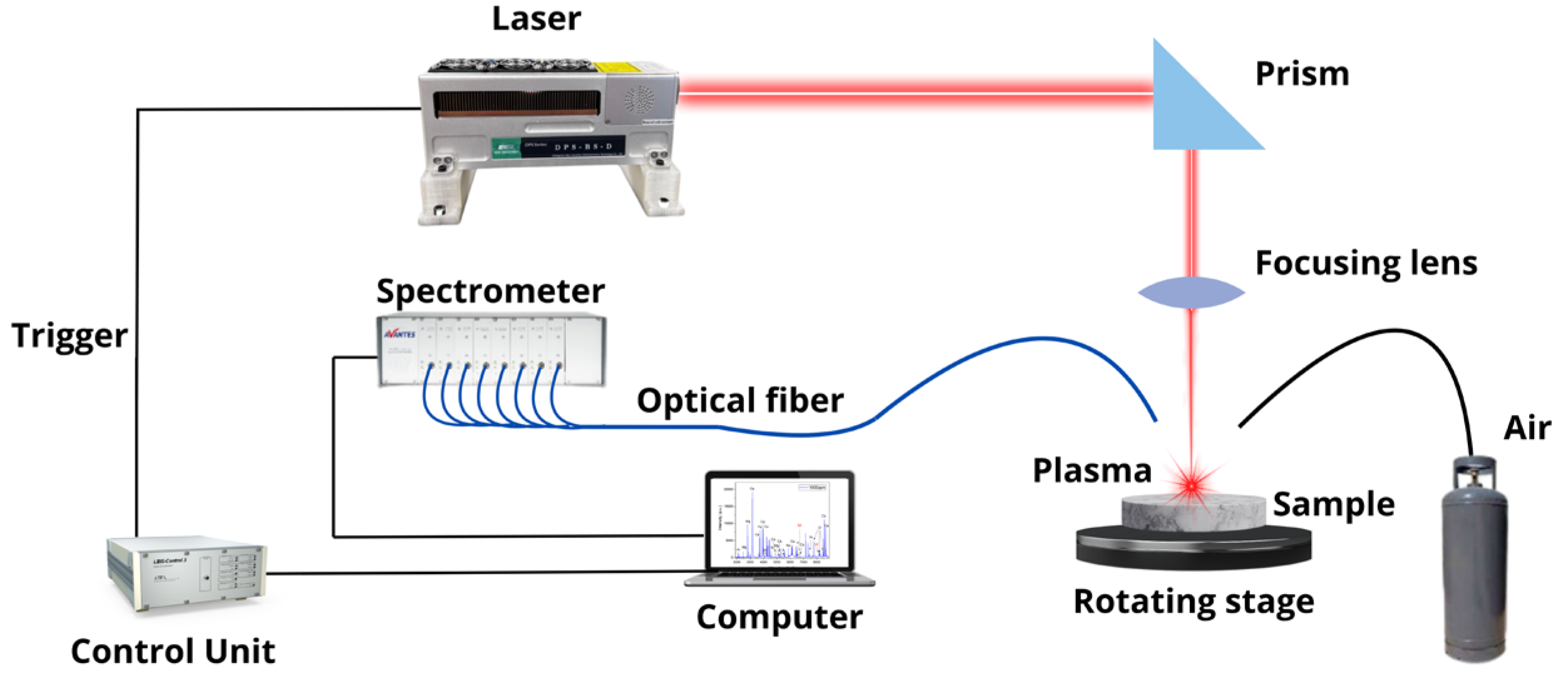
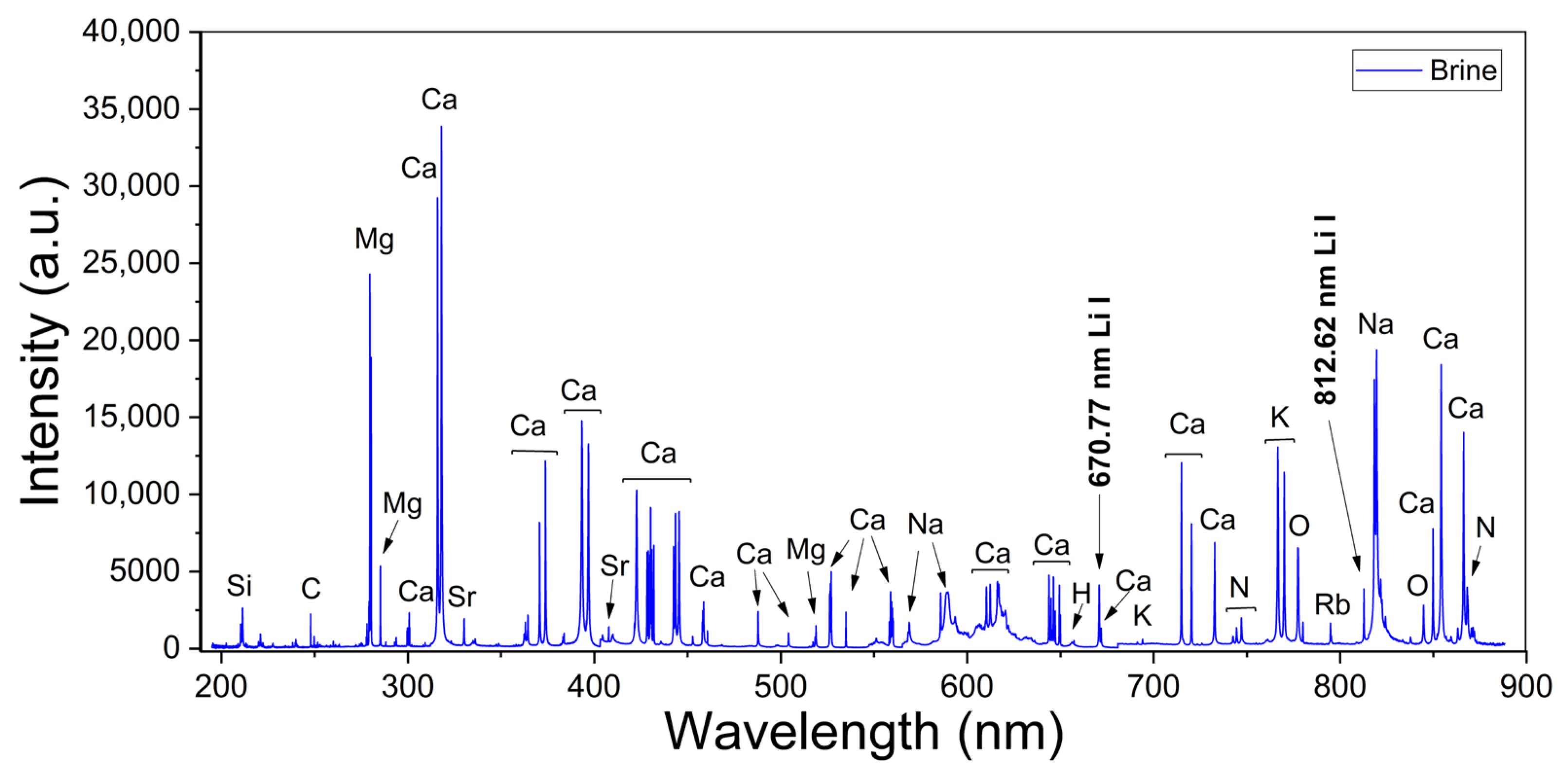
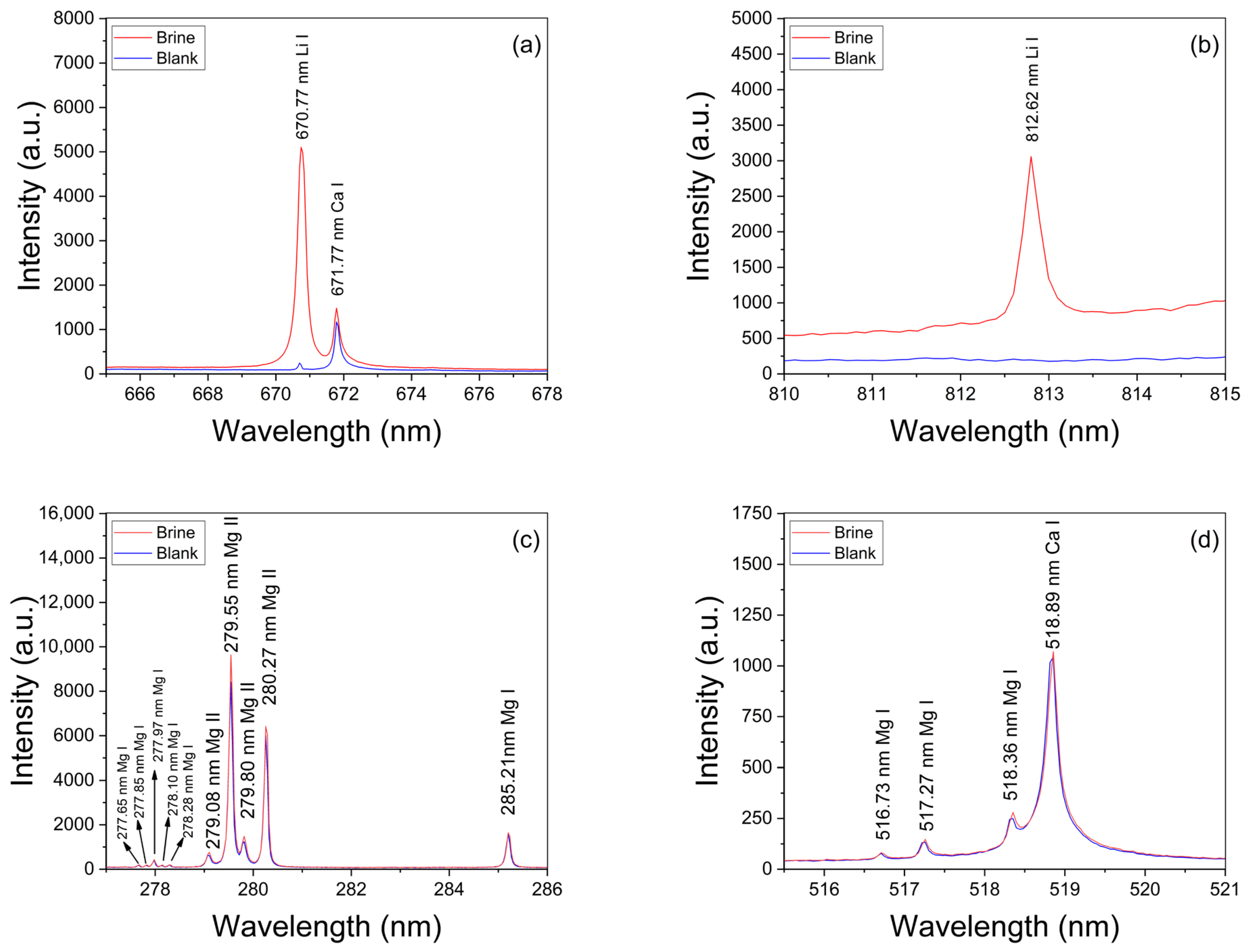

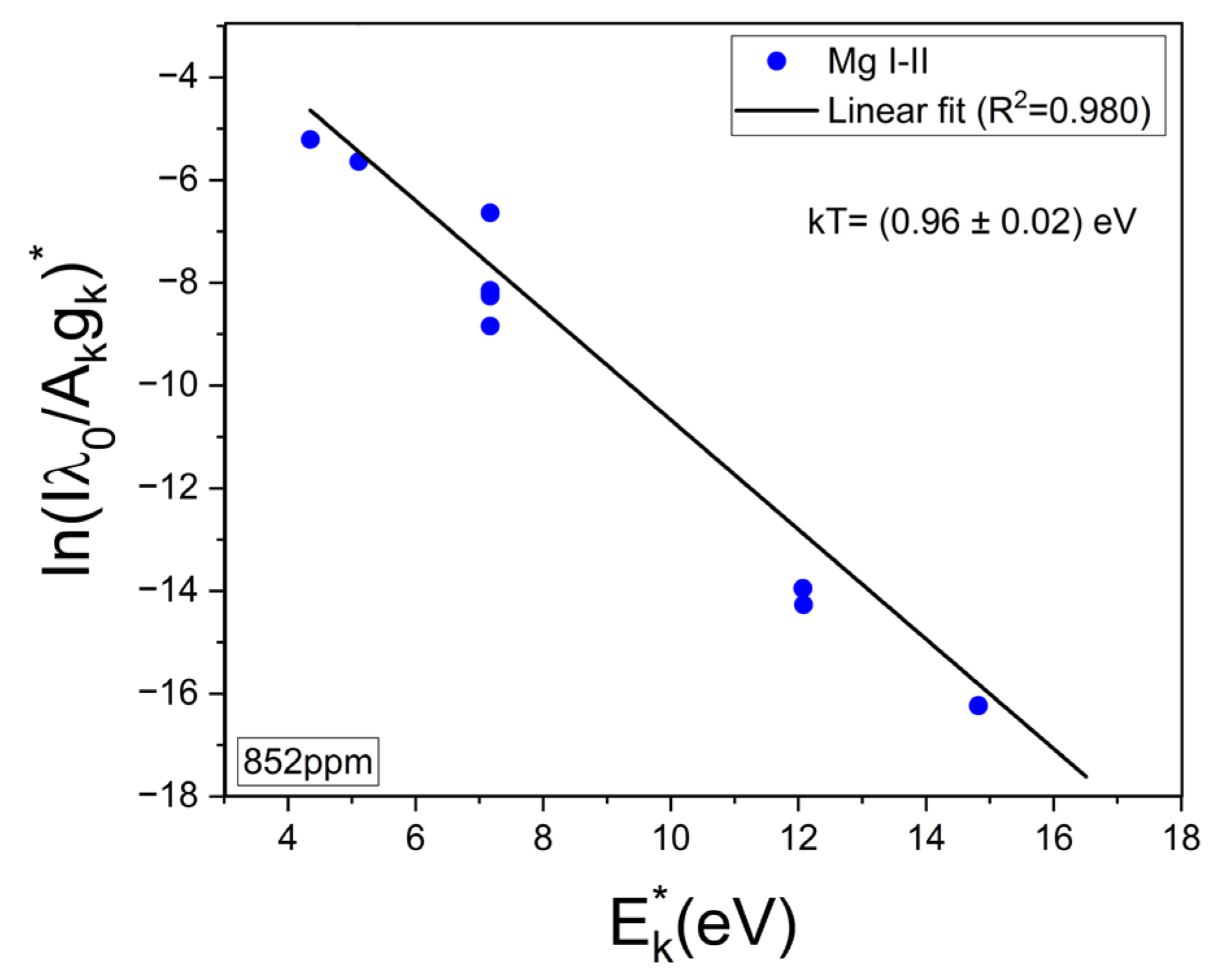
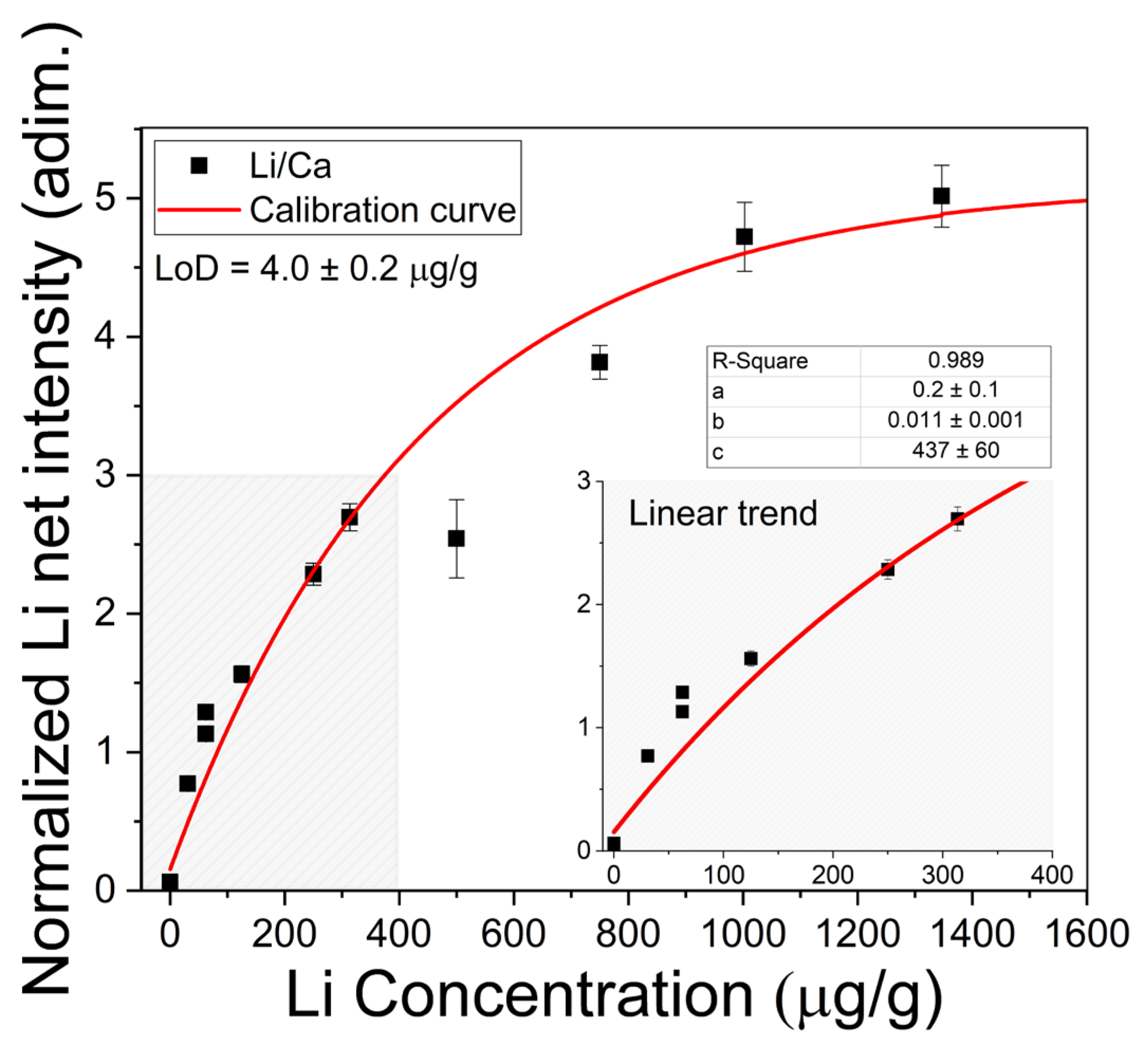
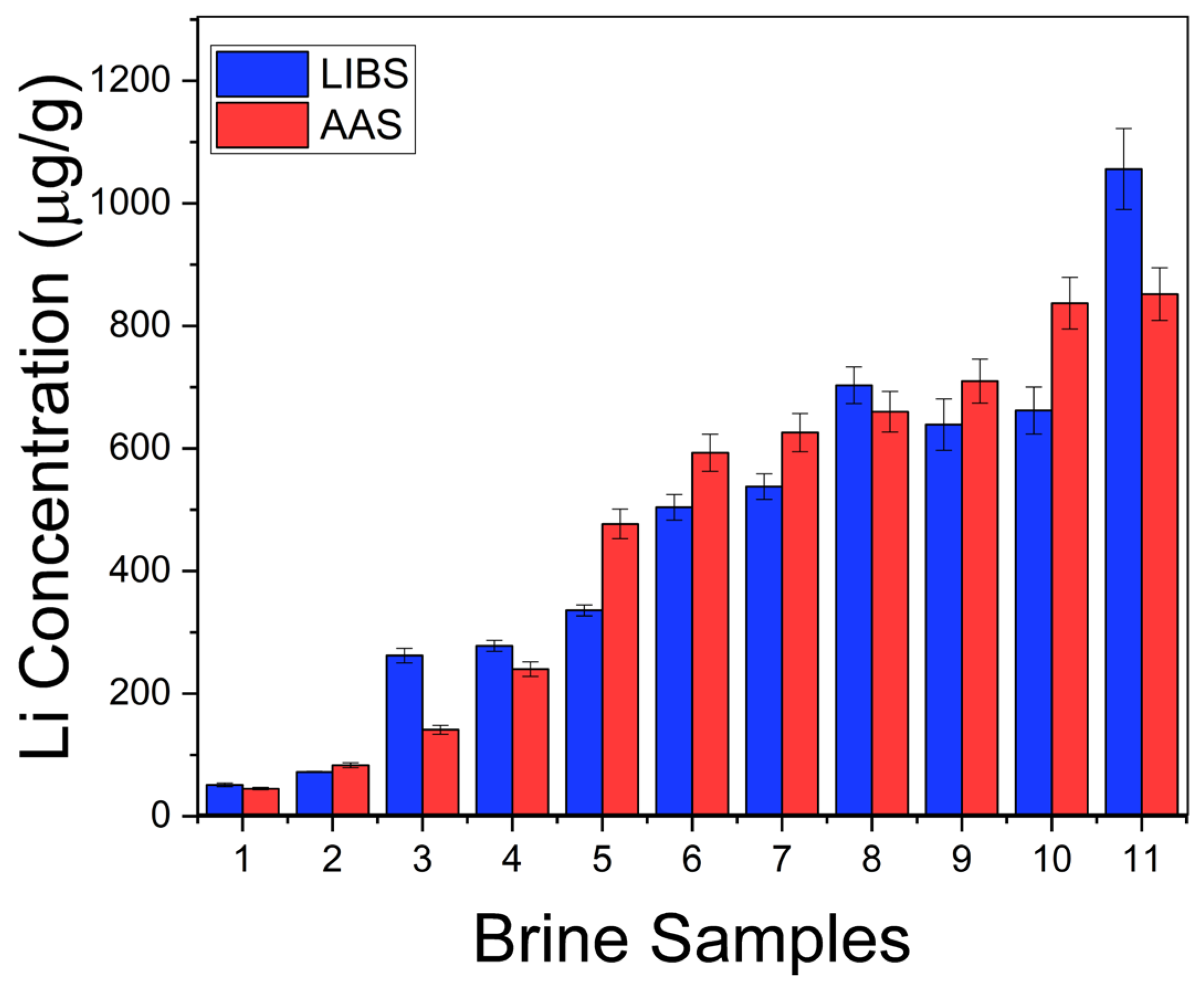
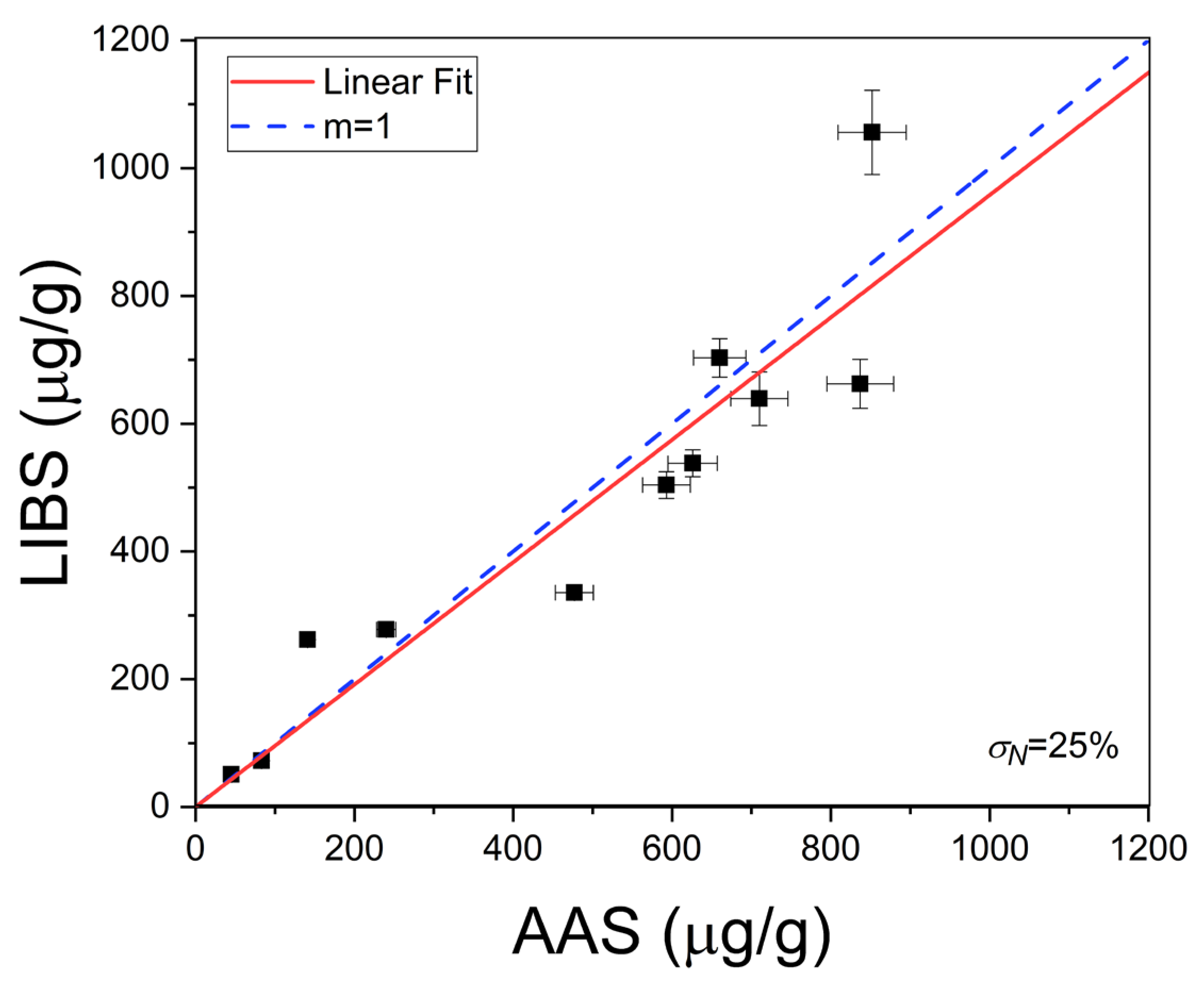
| Brine Samples | Li Concentration (µg/g) | |
|---|---|---|
| LIBS | AAS | |
| 1 | 51 ± 3 | 45 ± 2 |
| 2 | 72 ± 2 | 83 ± 4 |
| 3 | 262 ± 12 | 141 ± 7 |
| 4 | 278 ± 9 | 240 ± 12 |
| 5 | 336 ± 9 | 477 ± 24 |
| 6 | 504 ± 21 | 593 ± 30 |
| 7 | 538 ± 21 | 626 ± 31 |
| 8 | 703 ± 30 | 660 ± 33 |
| 9 | 639 ± 42 | 710 ± 36 |
| 10 | 663 ± 39 | 837 ± 42 |
| 11 | 1056 ± 66 | 852 ± 43 |
Disclaimer/Publisher’s Note: The statements, opinions and data contained in all publications are solely those of the individual author(s) and contributor(s) and not of MDPI and/or the editor(s). MDPI and/or the editor(s) disclaim responsibility for any injury to people or property resulting from any ideas, methods, instructions or products referred to in the content. |
© 2025 by the authors. Licensee MDPI, Basel, Switzerland. This article is an open access article distributed under the terms and conditions of the Creative Commons Attribution (CC BY) license (https://creativecommons.org/licenses/by/4.0/).
Share and Cite
Molina M., J.; Sarchi, C.; Tesio, A.Y.; Costa-Vera, C.; Díaz Pace, D.M. Quantitative Analysis of Lithium in Natural Brines from the Lithium Triangle by Laser-Induced Breakdown Spectroscopy. Atoms 2025, 13, 56. https://doi.org/10.3390/atoms13060056
Molina M. J, Sarchi C, Tesio AY, Costa-Vera C, Díaz Pace DM. Quantitative Analysis of Lithium in Natural Brines from the Lithium Triangle by Laser-Induced Breakdown Spectroscopy. Atoms. 2025; 13(6):56. https://doi.org/10.3390/atoms13060056
Chicago/Turabian StyleMolina M., Juan, Carisa Sarchi, Alvaro Y. Tesio, César Costa-Vera, and Diego M. Díaz Pace. 2025. "Quantitative Analysis of Lithium in Natural Brines from the Lithium Triangle by Laser-Induced Breakdown Spectroscopy" Atoms 13, no. 6: 56. https://doi.org/10.3390/atoms13060056
APA StyleMolina M., J., Sarchi, C., Tesio, A. Y., Costa-Vera, C., & Díaz Pace, D. M. (2025). Quantitative Analysis of Lithium in Natural Brines from the Lithium Triangle by Laser-Induced Breakdown Spectroscopy. Atoms, 13(6), 56. https://doi.org/10.3390/atoms13060056









